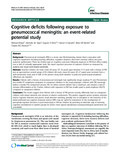Cognitive deficits following exposure to Pneumococcal Meningitis: An Event-Related Potential study

View/
Date
2012-03-31Author
Kihara, Michael
de Haan, Michelle
Were, Eugene O
Garrashi, Harrun H
Neville, Brian GR
Newton, Charles RJC
Type
Journal ArticleMetadata
Show full item recordAbstract
Abstract
Background
Pneumococcal meningitis (PM) is a severe and life-threatening disease that is associated with cognitive impairment including learning difficulties, cognitive slowness, short-term memory deficits and poor academic performance. There are limited data on cognitive outcomes following exposure to PM from Africa mainly due to lack of culturally appropriate tools. We report cognitive processes of exposed children as measured by auditory and visual event-related potentials.
Methods
Sixty-five children (32 male, mean 8.4 years, SD 3.0 years) aged between 4-15 years with a history of PM and an age-matched control group of 93 children (46 male; mean 8.4 years, SD 2.7 years) were recruited from a well-demarcated study area in Kilifi. In the present study, both baseline to peak and peak-to-peak amplitude differences are reported.
Results
Children with a history of pneumococcal meningitis had significantly longer auditory P1 and P3a latencies and smaller P1 amplitudes compared to unexposed children. In the visual paradigm, children with PM seemingly lacked a novelty P3a component around 350 ms where control children had a maximum, and showed a lack of stimulus differentiation at Nc. Further, children with exposure to PM had smaller peak to peak amplitude (N2-P1) compared to unexposed children.
Conclusion
The results suggest that children with a history of PM process novelty differently than do unexposed children, with slower latencies and reduced or absent components. This pattern suggests poorer auditory attention and/or cognitive slowness and poorer visual attention orienting, possibly due to disruption in the functions of the lateral prefrontal and superior temporal cortices. ERPs may be useful for assessment of the development of perceptual-cognitive functions in post brain-injury in African children by providing an alternate way of assessing cognitive development in patient groups for whom more typical standardized neuropsychological assessments are unavailable.
URI
http://dx.doi.org/10.1186/1471-2334-12-79http://erepository.uonbi.ac.ke:8080/xmlui/handle/123456789/14690
